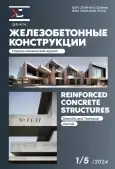Ensuring Seismic Resistance of Reinforced Concrete Buildings
- Authors: Mkrtychev O.V.1, Reshchetov A.A.1
-
Affiliations:
- Moscow State University of Civil Engineering (National Research University) (MGSU)
- Issue: Vol 5, No 1 (2024)
- Pages: 57-67
- Section: COMPUTER MODELLING IN CONSTRUCTION
- URL: https://ogarev-online.ru/2949-1622/article/view/252967
- ID: 252967
Cite item
Full Text
Abstract
About the authors
O. V. Mkrtychev
Moscow State University of Civil Engineering (National Research University) (MGSU)
Email: mkrtychev@yandex.ru
ORCID iD: 0000-0002-2828-3693
SPIN-code: 9676-4986
A. A. Reshchetov
Moscow State University of Civil Engineering (National Research University) (MGSU)
Email: andrew331@bk.ru
ORCID iD: 0000-0002-8267-2665
References
- Wolf J.P. Dynamic Soil–Structure Interaction. Englewood Cliffs, NJ: Prentice-Hall, 1985. 481 p.
- Basu U. Explicit finite element perfectly matched layer for transient three-dimensional elastic waves // International Journal for Numerical Methods in Engineering. 2009. No. 77(2). P. 151–176.
- Tamrazyan A. G. Reduce the Impact of Dynamic Strength of Concrete Under Fire Conditions on Bearing Capacity of Reinforced Concrete Columns // Applied Mechanics and Materials Collection of papers from 2nd ICSMIM, November 16-17, 2013, Guangzhou, China ed. Yun-Hae Kim and Prasad Yarlagadda Vol 1 pp 475–476.
- Cun H., Haixiao L. Implicit and explicit integration schemes in the anisotropic bounding surface plasticity model for cyclic behaviours of saturated clay // Computers and Geotechnics. 2014. Vol. 55. P. 27-41.
- Krysl P., Bittnar Z. Parallel explicit finite element solid dynamics with domain decomposition and message passing: dual partitioning scalability, Computers & Structures, Volume 79, Issue 3, January 2001, Pages 345-360.
- París J., Colominas I., Navarrina F., Casteleiro M. Parallel computing in topology optimization of structures with stress constraints // Computers & Structures. 2013. Volume 125. September 2013. Pp. 62-73.
- Jin H., Jespersen D., Mehrotra P., Biswas R., Huang L., Chapman B. High performance computing using MPI and OpenMP on multi-core parallel systems // Parallel Computing. 2011. Volume 37. Issue 9. September 2011. Pp. 562-575.
- Basu U., Chopra A.K. Perfectly matched layers for transient elastodynamics of unbounded domains // International Journal for Numerical Methods in Engineering. 2004. No. 59(8). P. 1039–1074.
- Murray Y.D. User’s Manual for LS-DYNA Concrete Material Model 159. McLean. Report No. FHWA-HRT-05-062. Federal Highway Administration, 2007. 77 p.
- Mkrtychev O.V., Reshetov A.A. Modeling Worst-case Earthquake Accelerograms for Buildings and Structures // Advances in Engineering Research. 2016. Volume 72. Pp. 89-94.
- Мкртычев О.В., Решетов А.А. Синтезирование наиболее неблагоприятных акселерограмм для линейной системы с конечным числом степеней свободы // International Journal of Computer and Communication System Engineering. 2015. Volume 11, Issue 3. Pp. 101-115.
- Мкртычев О. В., Решетов А. А. Представительный набор акселерограмм для расчета на сейсмические воздействия // Промышленное и гражданское строительство. 2023. № 9. С. 43-50. doi: 10.33622/0869-7019.2023.09.43-50
- Reshetov A.A, Lokhova E. M. Assessment of the influence of the rotational components of seismic action on the SSS of a multistorey reinforced concrete building (assessment of the influence of the rotational components of seismic action on the SS of a multistorey reinforced concrete building // International Journal for Computational Civil and Structural Engineering. 2022. Vol. 18. Iss. 1. Pp. 82-91.
Supplementary files






